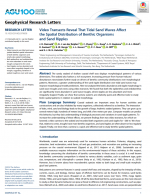The Pelagia-expedition of June 2017 has resulted in a scientific article! In collaboration with Johan Damveld and other colleagues of the Sandbox-project, Karin and Leo studied the effects of sand waves on the spatial distribution of benthic organisms and sand ripples.
By lowering the hopper camera from the NIOZ to the seabed, Johan and Karin could identify epibenthos (species living on top of the seabed), tracks of endobenthos (species living in the seabed) and determine the presence and structure of sand ripples. This was performed in sand wave troughs and crests, enabling a comparison of the two habitats.
It turned out that the troughs differed quite a bit from the crests. In the troughs, there were more epibenthos and more tracks of endobenthos. Moreover, sand ripples were less abundant in the troughs, and if abundant, the sand ripples were irregularly patterned and had shorter wave lengths.
The results show that sand wave model predictions, which are currently based on abiotic parameters only, could probably be improved by the inclusion of the detailed spatial distributions of both benthos and sand ripples. In addition, we have shown that video transects are an efficient method to simultaneously collect data on both benthic communities and small-scale morphology with relevant spatial resolution.

